
Next you will find out:
- How is the removal of wisdom teeth in the upper jaw;
- Interesting nuances of removal of a hidden wisdom tooth (impacted);
- Unpleasant complications that sometimes occur directly during the procedure;
- As well as the approximate prices for wisdom teeth removal in various dental institutions.
As practice shows, the fact of the impending removal of a wisdom tooth often causes panic fear in some people. Some wise Soviet past patients imagine this procedure in such a way that the dentist-surgeon will gouge out the roots in the old fashioned way with a chisel and a hammer for more than an hour, removing them from the torn bleeding gums ...
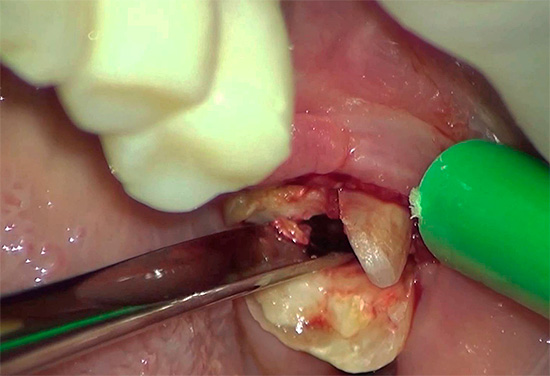
Well, we hasten to please you - in fact, the procedure for removing wisdom teeth today is usually much simpler and not as scary as described above.Although it is fair to say that there is some truth in such fears, since the upper wisdom teeth of each person have their own unique structure and location in the jaw, sometimes rather complicating their removal.
Due to the fact that the wisdom tooth erupts the most recent, often at the end of the dental arch, there simply is no room for it. With a close arrangement of the teeth and a small upper jaw, the upper wisdom tooth (the eighth) may not begin to erupt at all for a long time, resting its crown on the adjacent seventh one. At the same time, serious problems often arise: pain, swelling of the gums and cheeks, and all this leads to the fact that a complex removal of the wisdom tooth is carried out in the upper jaw, the interesting and important nuances of which we will discuss further in more detail.
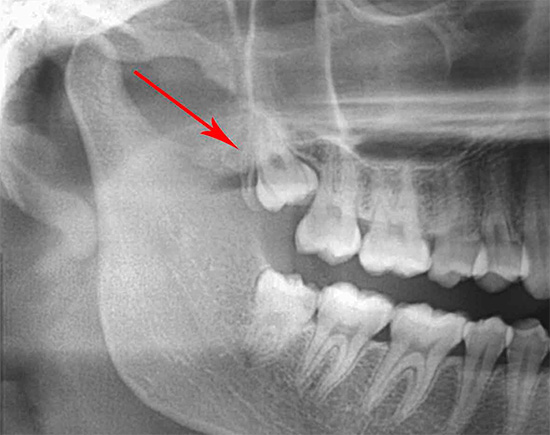
Feedback
“I was not lucky at all, the doctor said that he would not pull out, but cut, because there are no sevens, and the wisdom tooth is hidden under the gum and presses on the six. I have a panic, I'm afraid of dentists in general! It is clear that with anesthesia, but he will cut out a piece of gum to me! And then he also said that the implant will be set - they will drill my jaw, and then the screw will be screwed right into the bone.Oh, girls, how not to die there ... "
Varvara, Kirov region
Fortunately, the difficult eruption of the 8 tooth from above is extremely rare (compared to the wisdom teeth in the lower jaw), so its removal in practice in most cases is not difficult for the dentist-surgeon.
As usual, the removal of the upper wisdom teeth
Removing a wisdom tooth in the upper jaw is usually not difficult in the following cases:
- A tooth has one or more roots fused together;
- The root is almost straight and not too long;
- The crown portion is completely or 90% above the level of the gum, which makes it possible to cover it tightly with forceps.
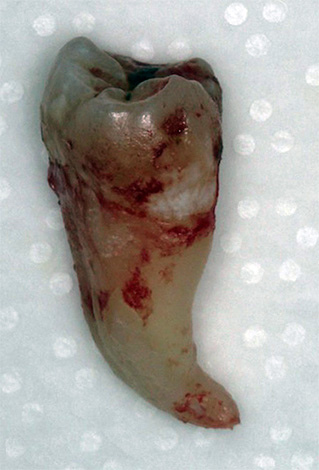
In such cases, we are talking about simple removal - that is, removal using forceps.
The structure of the forceps to remove 8 teeth from above has its own characteristics associated with difficult access to it. Often, the dentist-surgeon has to deal with the teeth of wisdom heavily destroyed by caries on the upper jaw, therefore, bayonet (bayonet) forceps are used for their “dislocation” from the hole, which are ideal for this.
It is interesting
Dentists-surgeons use bayonet forceps quite often, as they have a special configuration, which is very convenient for removing roots of distant molars. The cheeks of these forceps are sharpened to improve the fixation of the root to be removed and are completely closed, unlike forceps for the extraction of a tooth with a preserved crown.
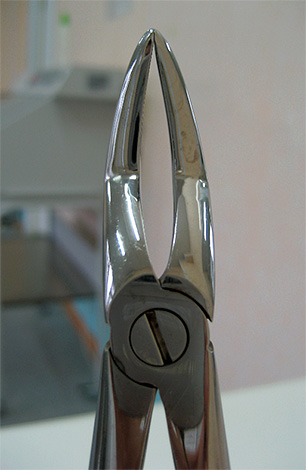
Bayonet tongs are used not only to remove the roots of the 8th tooth on the upper jaw, but also on the sixth, seventh upper, and also often “capricious” roots of the five and four. With a special skill with these tools, you can remove the root and upper front tooth, for example, the central incisor. Dentists and surgeons love and appreciate these forceps for their versatility and ease of operation.
Dentist recall
“I have been working as a dentist-surgeon for about 15 years and I cannot imagine my practice without bayonet tongs. One time I had to start in a deaf village, people per 500-800 people. In the hospital there, I was in great demand not only among the local population, but also the neighboring villages often came to me to remove one or several teeth, since before that they had not had a dentist for more than 3 years.The tools were generally weak: there were 15 pieces of medical replacement (and several elevators), and most of them were bayonet-shaped forceps to remove the upper roots of wisdom teeth, molars, premolars, canines and incisors.
On the day, more than 10 people often came, and at the end of the shift there was nothing left - 3-4 tools of the same type. Then I was rescued by savvy: bayonet tongs were perfect not only for removing teeth with a preserved crown, but also for removing almost any lower tooth. For this, the patient’s backrest went down to such a level that the head was thrown back, and I came up behind, and it turned out that the lower jaw started to be positioned at the top, therefore with bayonet-shaped forceps that remained at the end of the shift, it was possible to remove any not very complicated tooth on the lower jaw. Now I do not use the product of my ingenuity, as there are plenty of tools, but for military field conditions it is a great option. ”
Alexey, dental surgeon, Norilsk
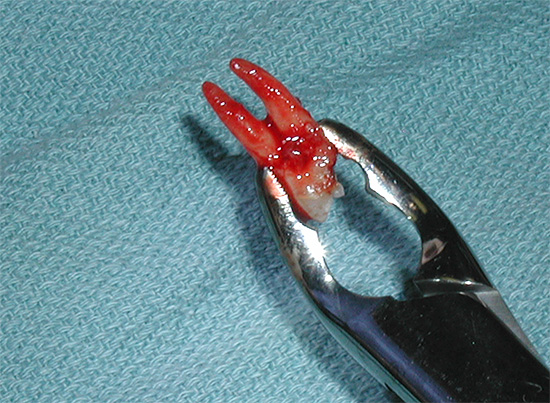
Before surgery, a dentist-surgeon most often takes an x-ray of a wisdom tooth to be removed, as this allows to anticipatewhat is to be removed (simple or complex), and also prevents a number of serious complications (for example, perforation of the maxillary sinus, damage to the adjacent tooth, etc.). After that, the patient is interviewed for the presence of comorbidities (collecting history), examining the tooth and selecting the necessary set of tools, removing plaque from the tooth being removed and antiseptic treatment of the oral cavity in the form of rinsing - for additional prevention of suppuration of the hole in the future. Then high-quality anesthesia is performed.
The main stages of simple removal of the upper wisdom tooth:
- Imposing forceps on the crown or root in the hole;
- The advancement of the forceps is slightly deeper;
- Fixation;
- Luxification (swinging) of the tooth in the direction of least resistance - into the outer (to the cheek);
- Traction (extraction from the hole);
- Hemostasis - stopping bleeding from the hole by applying a sterile gauze pad and pressing it strongly against the wound with opposing teeth.
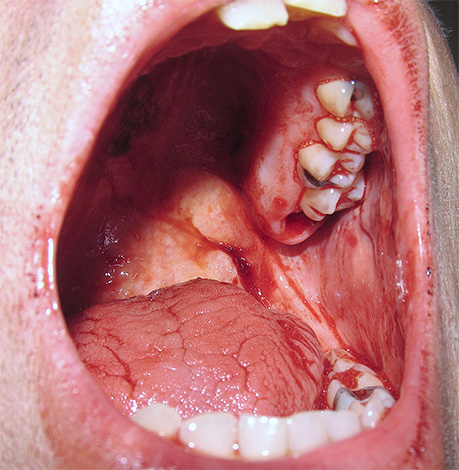
After the removal procedure is completed, the dentist-surgeon makes valuable recommendations to the patient for the care of the postoperative wound: what can and cannot be done, which drugs to use, how many days, etc.
Features of removal of the polyurethinized and retired upper wisdom teeth
As already mentioned above, there is often not enough room for the teeth of the upper jaw in the dentition. Every dentist practically every day sees an unusual arrangement of the top eight - the so-called dystopia.
The wrong position in relation to the dentition looks most often as follows: during teething, the tooth strongly deviates to the side of the cheek and sometimes even begins to injure its mucous during chewing. In old age it is especially dangerous, as long-term healing wounds ulcerate and can cause the development of the tumor process. Therefore, it is important to diagnose such a tooth in time and immediately remove it.
Sometimes due to the lack of free space in the jaw or improper location (for example, a strong tilt in the direction of the 7th tooth), the upper wisdom tooth may cut through partially (polyurethinized) or not appear at all on the surface of the gum (impacted).In such cases, the question arises: should it be urgently removed?
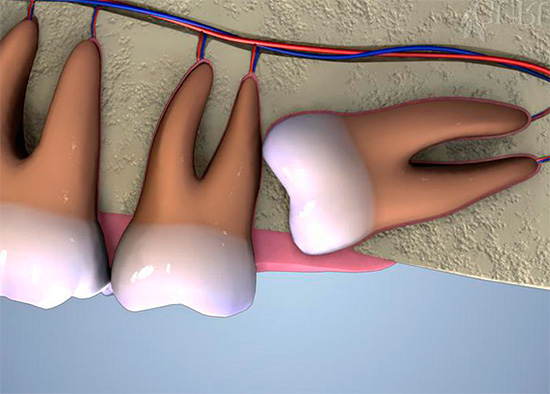
To solve the problem of the removal of a polyurethinized and impacted wisdom tooth in the upper jaw, they are suitable from a professional position: if the tooth does not cause anxiety and does not create a clear threat of the development of complications in the future, then it is usually not touched, but they are dynamically monitored at least 1-2 times a year.
It is important to know:
A impacted tooth must be removed urgently in case of pain, inflammation, as well as in the formation of a follicular (tooth-containing) cyst around it.
Before removing the 8th tooth from above (as well as 6, 7, 5, and 4th), an x-ray analysis is carried out, which allows determining the boundaries of the maxillary sinus with respect to the tooth roots: the closer the location, the greater the risk of its perforation or perforation.
Now let's see what stages of removal of the impacted upper wisdom teeth you can expect in the dentist’s office:
- Local anesthesia;
- Incision of the gums with a scalpel and flaking of the flap;
- Bone resection using tips and special cutters at low revs with cooling so that there is no necrosis of the bone (if the impacted tooth is not surrounded by bone tissue, then it will not be necessary to cut it out);
- Tooth extraction in parts or in whole with the help of elevators or tongs;
- Curettage wells and washing with antiseptics;
- Bone wound plasty with biomaterials (autogap, hydroxyapatite, tricalcium phosphate);
- Return of the mucous flap to its former place and suturing;
- Stop bleeding from the hole;
- Recommendations for the care of postoperative wounds.
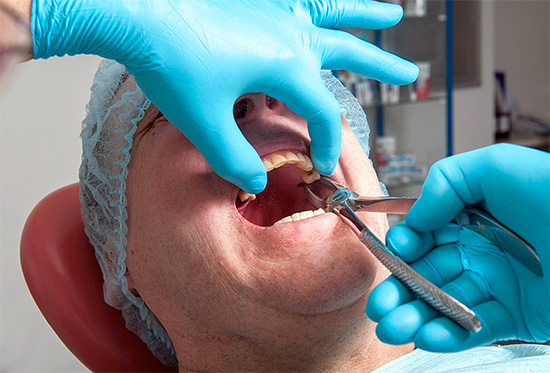
Dental Surgeon Comment
Many doctors, for the convenience of removing the impacted wisdom tooth in the upper jaw, practice splitting it in parts, but it’s best to give up this stage and try to carefully isolate the entire tooth from the hole. This is due to the fact that the roots can be closely located to the maxillary sinus, and the separation of the roots (and even more so their gouging) can cause the tooth part to fall into the sinus, and it can be very difficult to get it out from there.
Anesthesia or local anesthesia - what to prefer?
What anesthesia can be used to remove the upper wisdom tooth: general (anesthesia) or local? This question is of concern to many people who face this procedure.
Teeth anesthesia It has certain advantages, as it allows you to transfer all the most "terrible" manipulations with a disabled mind.However, anesthesia is not without drawbacks: specific preparation for it, increased cost of the whole procedure, and sometimes unpleasant feelings after it. In addition, there are cases when, after anesthesia, people “did not wake up at all”, as there are a number of diseases that determine the risks of a reanimation situation during a doctor’s work.
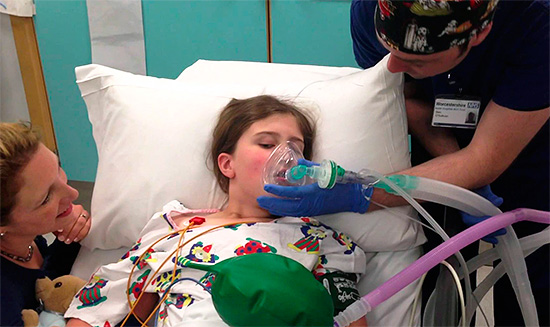
Therefore, most often the upper wisdom tooth is removed under local anesthesia. Highly effective anesthetics of the Artikaina series are usually used, as a result of which there are practically no problems with poor freezing.
On a note
The upper wisdom teeth are surrounded by a thin cortical plate that has small holes for the exit of blood vessels and nerves. That is why, in comparison with the teeth of a massive and dense lower jaw, the upper teeth (including the wisdom tooth) are not hard to "anesthetize".
Most often, infiltration anesthesia is done, in which the anesthetic solution is introduced into the transition fold (in the projection of the roots of the wisdom tooth on the gum). Sometimes they perform the technique of tubular and palatine anesthesia - with the failure of the first.
To increase the time of the “freezing” action, adrenaline or norepinephrine (vasoconstrictors) is added to the anesthetic, which, as a vasoconstrictor, reduce the resorption rate of the anesthetic, thereby keeping it in the working area for a long time. As a rule, the duration of action of drugs with the dilution of adrenaline 1: 100 000 allows for a painless tooth extraction for about 1 hour.
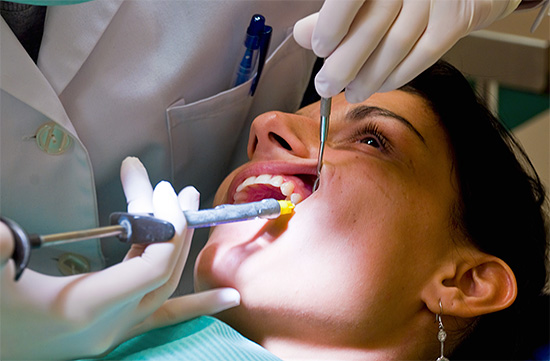
In case of intolerance to local anesthetic, panic fear of surgery, mental disorders of the patient, duration and high trauma of the upcoming intervention, etc. wisdom tooth extraction is performed under anesthesia.
What complications can occur directly during the removal of the upper wisdom tooth
Despite the fact that the upper wisdom teeth are often not difficult to remove, in certain cases there are still serious problems leading to complications during the intervention. And in 90% of cases they are associated with the lack of professionalism and the rough work of the dental surgeon.
It is interesting
When removing any tooth, the use of brute force on the part of the doctor is exclusively contraindicated.There is a well-known myth given that a huge, pumped-up male surgeon will cope with removal better than a small, subtle young lady dentist. However, in practice it turns out that it is she who will perform the task better.
Competent dentists with great experience know that the removal is done first of all not by forceps, but by hand. Tongs (and other tools) is just a continuation of the surgeon's hands, and where there are hands, a competent head must also be attached. During removal, no excessive force is applied, but the well-known principle of leverage is used, supported by accuracy and experience. If the tooth doesn’t "go" during the extraction, there is no sense to lean on the forceps to do the work faster. At the moment there are other optimal ways (except for forceps and elevators) to extract a tooth without the risk of complications during surgery.
So, we list the main complications that may arise during the removal of a wisdom tooth in the upper jaw:
- Fracture of the crown or root of the tooth being removed. It occurs when the crown or root is significantly destroyed by the carious process, and the forceps superimposed squeeze them with uncontrollable force.In this case, a “crunch” and “crackle” usually arise, frightening the patient and causing him to spit out the remnants of the tooth being removed. Prevention of this complication lies in the accuracy and control of the degree of pressure of the forceps on the captured tooth, as well as in the depth of its grip (the deeper the cheeks under the gum are - the less risk that a crown or root fracture occurs).
- Fracture and dislocation of the adjacent tooth. This complication does not occur often, but is also associated with the use of force and a small experience of the doctor. When working with elevators, the dentist-surgeon can choose a weak single adjacent tooth as a support and, in case of violation of the work technique, make a fracture or dislocation. Therefore, it is important that there is at least one more adjacent tooth near the abutment tooth.

- Damage to the gums and other soft tissues of the oral cavity. This complication occurs quite often, especially during difficult removal. Often, damage to soft tissues is due to the complexity of the location of the wisdom tooth (this may concern both the upper and lower jaws) and the difficulty of extracting it when all the attention of the doctor is directed to the tooth being removed and the breaks in the soft tissues are ignored.Damage may occur when the instrument slips off, and the doctor may simply tear the corners of the patient’s mouth, trying to get better access to the tooth being removed. To prevent such complications, it is important for the doctor to learn how to control their actions as much as possible.
- Pushing the root into the surrounding soft tissue. During rough work with the elevator, sometimes the root moves under the gum, and attempts to grip it sometimes push the root even deeper. Therefore, the doctor subsequently has to cut the gum over it in order to easily remove the problematic piece of tooth. Prevention of complications is still the same accuracy in work and utmost attentiveness.
- Breakaway of the site of the alveolar process - occurs when the teeth of the forceps of the tooth being removed are too deeply caught by the cheeks, when they are also applied to a part of the alveolar process. This complication usually does not lead to impaired healing of the hole, but the sharp edges of the damaged bone tissue should be smoothed, for example, with bone nippers (for the prevention of inflammation of the hole - alveolitis).
- Perforation of the bottom of the maxillary sinus.Currently due to compulsory radiography before the removal of a wisdom tooth this is a complication It is not so common, but it is one of the most unpleasant in all senses (see the review below). Its prevention is: X-ray control before removal, not using a doctor of excessive force directed toward the root or part of the tooth to be removed, as well as a good knowledge of the anatomy of the upper jaw.
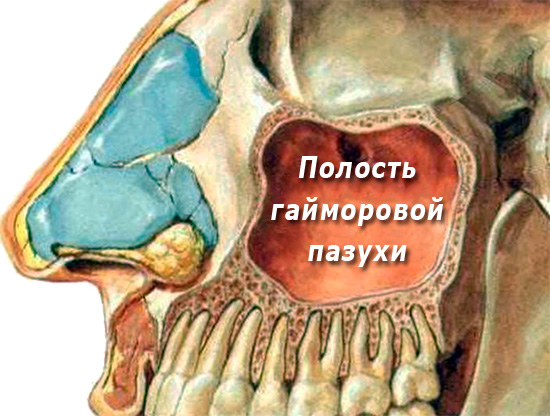
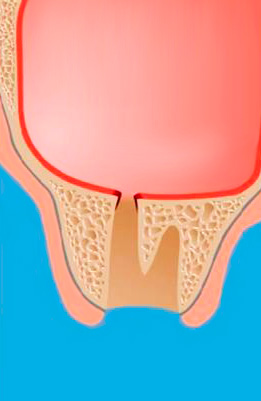
Feedback
“Yesterday I removed the upper wisdom tooth in our local clinic near the house. Frozen gums and jerked well, just some 3-4 minutes sat in the chair. I came home, took Ketorol's pill and decided to have something to eat after a couple of hours. At hand was my mother's chicken soup with noodles. Only when I started to wind him up, as the soup began to flow from my nose! At first I did not even understand, I thought it was a cold. But it was a soup! Horror, I almost did not crash from the chair. For 15 minutes I was sitting like that, and then I realized that it was somehow connected with a hole in my mouth from my former wisdom tooth. Immediately I started in the direction of the clinic, where a few hours ago I had a tooth pulled out. It turned out that I have a hole in the gum communicating with the nasal cavity, so the food flows through the nose.I asked the doctor to fix a hole for me, to which she replied that they did not do such an operation. Well, actually, I almost died of fear, when I almost crawled out of my nose, and she screwed up and said she could not do anything. I had to go to another private clinic, where, for five thousand, I was kindly sewed everything up. Now nothing comes out of the nose. In theory, it’s not a pity for money, it’s a shame that the clinic doesn’t understand what’s going on: they will make business in the bushes. Where the world is heading! ”
Nastya, Nizhnevartovsk
The approximate cost of removing the top "wise" teeth
Depending on the level of the dental organization, the prices for the removal of a wisdom tooth can vary from absolutely free removal by compulsory medical insurance to about 5-10 thousand rubles.
The main advantage of a budgetary institution (and, perhaps, the only thing) is the low price for the service - often, the teeth are completely removed here, but often the procedure is performed with domestic anesthetics, which are not very effective, and in addition are still toxic and allergenic. In addition, you have to hatch long queues. Also, not all hospitals and clinics will take up the complex upper wisdom tooth,and will be sent to another hospital or even to a private clinic - due to lack of equipment, tools, experience, or due to the lack of desire to mess with you for a long time, etc.
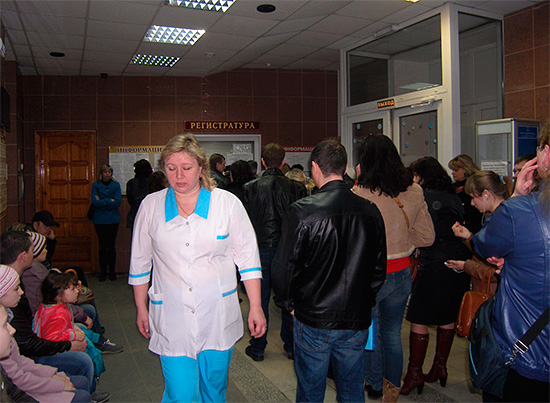
The advantage of a private blade is an individual approach to each patient (although there are also private dentistry, where they practice conveyor techniques). An important disadvantage of many private organizations is that the price lists do not focus on simple and complex removal, but simply on the wisdom tooth. That is why not the most honest dentists even make a simple ritual out of simple wisdom tooth removal: with preparation, acting playing a difficult removal with long conversations after that the extracted tooth had unusual roots that miraculously managed to pick up, and this is the merit of the dentist -professional ...
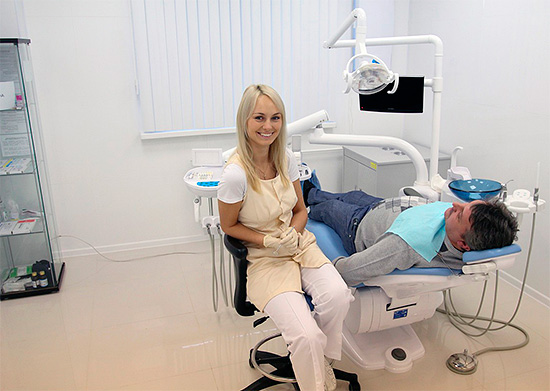
Unfortunately, no one is immune from excessive cheating for these types of services, but there are some tips that will help you avoid meeting with such doctors. Before turning to a dentist-surgeon for the removal of a wisdom tooth, you should conduct a “monitoring” of the clinic and its specialists: ask relatives and friends, find reviews, find out the long-term results of “experienced”, etc.All this will allow to find that dental surgeon who will carry out the wisdom tooth removal professionally and at a real market price, without pathos and unnecessary cheating.
Interesting video: an example of atraumatic removal of a wisdom tooth in the upper jaw
Some problems that may arise after the removal of teeth


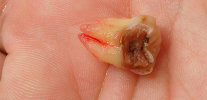

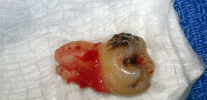
Tell me, please, I had a wisdom tooth removed and a year later a tooth was removed next to it (it turns out, 8 and 7 teeth) on the left side above. The rest of the teeth, it seems, is everything. Face asymmetry will be?
Hello! I think that there is no risk due to the fact that the 7 teeth are almost always not prosthetic when it comes to the end defect. Each tooth, of course, is important for the continuity of the dentition, but only starting from the sixth tooth to the first (central incisor), if they are lost, we are already talking about possible deformations of the maxillofacial region, in particular, asymmetry. So do not worry yet.
Please tell me you need to remove two retained wisdom teeth (upper right and lower left). Is it possible to immediately two? If the problem is only in nutrition, then it is not a problem. A month ago, the lower right retented eight was removed.
Hello! If there is no urgent need, and the deadlines for certain reasons are not tight, then it is best not to do it. First, the removal of retained teeth often takes more than 1 hour, so removing two teeth at once is morally hard.Secondly, the fact of the operation in different areas of the jaw will determine two wounds in the oral cavity, which will create risks for not very comfortable healing, although this is not always the case. In a planned manner, I would not advise you to remove two teeth at once, although the last word belongs to your treating maxillofacial surgeon or dental surgeon. If he takes responsibility, then there will be no mistake, in principle. Moreover, a professional can remove two retented teeth in 30-40 minutes without consequences. A correctly assigned postoperative treatment allows to make the healing of even two holes at the same time as comfortable as possible.
Hello! Tell me, is it normal that the doctor tried to remove the top 8 encylled 8-ku for 2 hours, in the end, as he said, the tooth did not succumb at all, the doctor sewed up the gums (together with the unremoved tooth) and said that it was removed under general anesthesia. He tried to drill it, but the tooth itself, he said, was intact. According to the doctor, no consequences, inflammation should not be, is it? And where to find a really good surgeon who can make a difficult removal, although now it is very scary to think about re-execution ...
Hello! From the point of view of logic, the dentist did nothing shameful (unless, of course, he missed the money for useless work). He honestly told you that he didn’t cope with the task - I’m more than sure that he suffered with a tooth in 2 hours, it is possible that he didn’t have enough special tools and / or skills of such deletions.
I can well assume that in the process of work the doctor discovered a large distance to the impacted tooth, considered that he could break the wood, therefore, anticipating an even greater trauma for the future, suggested that you remove the tooth under anesthesia, as anesthesia makes it possible to have a number of advantages in such operations .
It is respectful that the doctor did not conceal the information from you, did not throw the wound, but took it down, poured over you for two hours and gave you very good advice: well, if he cannot do his (in this case very complicated) work , that him now, to dismiss something for it? If general surgeons who don’t cope with difficult situations at least 1-2 times a year, will be dismissed, then there will not be a single attending physician who could help millions of people every year.
The last question puzzled me. Proceeding from ignorance of the location (where you come from), I can answer that you should look for a maxillofacial surgeon, better than a senior lecturer or professor at the medical institute, who has much more experience with such deletions. This is an option that will certainly help. Professors can do the job expensive, but in less time, if, of course, these are not rusted theorists.
Hello, I have such a problem: the upper seventh teeth grow on the gum, I do not feel any discomfort, but now a wisdom tooth climbs, which also grows on the gum. Is this fraught with consequences?
Hello! Upper wisdom teeth almost never cause problems. The exceptions are cases when they interfere with the adjacent tooth. So the probability of something very bad is very small compared to the same situations, but in the lower jaw.
However, sometimes the upper wisdom teeth erupt from the side, "crooked", and at the same time cause cheek biting. This is a negative point - in such situations it is usually better to remove the wisdom tooth in order to avoid consequences.You write that a tooth grows “on the gum” - do you mean that it is “exactly”? If so, then I think that it will occupy its normal location and will not cause you any concern.
Hello! The upper wisdom teeth, the left one began to crumble on the side, there is no pain. I went to the hospital, the doctor examined, said he could not remove it. A year has passed, a third of the tooth has broken off. I signed up for an appointment at the clinic, for an examination in a week. 6 months ago, the right tooth began to crumble, and also the side - a whole tooth, only a hole on the side. If you delay with the removal, then after you have to do everything under general anesthesia, as I understand it? And at what interval is it possible to remove them without complications? Thanks in advance!
Hello! The upper wisdom teeth in the vast majority of cases are easily removed. Complicated removal of the upper eighth teeth is rare. To confirm the complexity, in terms of the anatomy of the roots, a snapshot is taken before removal. Branched roots, curved at different angles, are found in 1-3% of cases, and in some regions of Russia - even less often. Personally, in 10 years of work, I only 4-5 times faced with complex upper wisdom teeth (although I have already deleted several hundreds of such teeth).
If your doctor did not remove the wisdom tooth only on the basis of an external examination, this is the wrong tactic. Rather, due to lack of experience, since most dentists-surgeons (including me) have a great love for removing the upper wisdom teeth (because it is easy to remove) and do not give up on them only by external examination of the destroyed coronal part.
If you tighten with the removal of wisdom teeth, you may have to remove them already in the presence of edema, and this complicates the work of the doctor and the rate of onset of anesthesia (its quality). Under general anesthesia, impacted teeth, polyurethane and wisdom teeth with special roots are sometimes removed. As I said, the latter comes across extremely rarely. So you are almost 100% threatened with removal only under local anesthesia.
The interval for scheduled deletions is worth doing this: about 2-3 weeks between deletions. Personally, I advise you to do a second removal after 2 weeks, if all the symptoms of the first disappear. There should be no lack of comfort on both sides at once (otherwise there may be problems with eating). So look for a professional dental surgeon with experience. And good luck!
I sometimes have cheek bite on the side of wisdom teeth, but quite rarely. They, in principle, do not interfere with me, these wisdom teeth. I do not know what to do, delete them or not? What could be the negative consequences in both cases?
Hello! Biting the cheek is most likely due to the fact that one of the wisdom teeth or both were cut with a deviation. In such cases, removal is recommended, since chronic chewing of the cheek (frequent injury to the oral mucosa) can lead to the development of malignant tumors. Consult a maxillofacial surgeon or a competent dentist-surgeon for advice and draw up a plan for solving this issue with a specialist.
Hello! I do not know much about my teeth, but I have to go to the dentist to remove 8 teeth on the right side. The upper tooth is covered with gum, it cuts my cheek to wounds, and it is one of two parts, as it were. Below the tooth grows wrong, somehow sideways. Another doctor said that my mucosa is inflamed. This is because of the wound, as I understand it, and the microbes in it ?! Please tell me how I will remove 8 teeth? Is it true that it is so painful, before losing consciousness, and that they will cut my gum from a tooth? I am very afraid ((
Hello! I think that with adequate anesthesia and the professionalism of the surgeon, there will be no pain at all at the time of tooth extraction. But is it worth it to delete two teeth at a time - that’s the question. Is there a testimony to this?
As for the gums: sometimes it needs to be adjusted in order to have normal access to the tooth. Sometimes two teeth are removed under general anesthesia if there are problems with local anesthesia. Especially when there is a panic fear of surgery or the "fear of a white robe." I am sure that you should find a good specialist and trust him. And you should not be afraid, because today there is a large arsenal of tools to make the procedure as comfortable as possible.
Hello, I have a large piece of the coronal part (more than half of the tooth) broke off from the top eight on the right. The pulp, as I understand it, is whole, but immediately began to hurt everything. Tomorrow I'll go to the doctor to delete. Please tell me if it is very difficult for a doctor to work because a tooth is so destroyed?
Hello! Of course, this makes it difficult to work.However, it should be borne in mind that in practice, the teeth are often not completely healthy and completely removed, but when they have already “rotted” or collapsed. Wisdom teeth are an exception - they can be removed without destruction for a number of reasons (incorrect position, mucosal injury, orthodontic indications, etc.). But even wisdom teeth in more than 90% of all appeals are destroyed to one degree or another. Therefore, if the doctor tells you that he will not take it, because the tooth is badly damaged, then run away from this doctor - he simply has no experience, desire, time or tools to help you with this event.
How hard it is to work the destruction of a tooth is quite a difficult question, because everything is individual. It happens that a strongly destroyed upper wisdom tooth is removed in 10-15 seconds, and almost the whole can take up to 30-50 minutes of time and even more. It depends on how a person opens his mouth, how convenient access to the tooth is, whether there is a seventh tooth nearby, whether the 8 tooth is shifted to the side (cheeks, palate, distal), how many roots there are (if more than 2, the process may be hampered) are they bent (if at an angle closer to 90 degrees,then it is extremely difficult to work), in which direction is the bend (God forbid, each root has its own trajectory), how massive is the jaw (alveolar process), etc. Nuances mass.
Thanks for the detailed answer, everything is fine, the doctor removed the tooth in 10 seconds ... There were two roots, one even, and the other was all curved.
Hello! The top eight are loose. Go pull out, or slowly the tooth itself falls out?
Hello! It is better, of course, to remove the professional. The fact is that while the tooth is mobile, it is a focus of infection - food with bacteria gets under the gum, the whole thing rots and causes bad breath. Also, I can’t help but say that I am often treated with moving teeth to be removed, since even the slightest touch of a tooth causes severe pain. Even in such neglected cases, the chance to remove a highly mobile tooth at home is small — the gum continues to hold the tooth tightly enough. So it's better at the dentist.
Thank you for your reply! Still, the tooth fell out itself, the root was accrete, with a slight bend, so no painful sensations arose.
Good day, removed 8 from the top, left the root, which subsequently went into the sinus. The doctor took all the responsibility away - he said, yes, my mistake, and you go to Laura at your own expense and do the operation. Of course, I am at a loss to see what the operation is and how expensive it can do, with what consequences does it go? Does it make sense to sue a doctor? Tell me please.
Hello! For wisdom teeth, the connection of the roots with the maxillary sinus of the nose is an infrequent situation. I think she put a dentist in a dead end, and he simply got scared sending you to an ENT. Maxillofacial surgeons, as well as surgeons of ENT departments, deal with these problems and do similar operations to extract roots.
Naturally, the root did not "go down into the sinus afterwards", and during the tooth extraction, the root was pushed into the sinus (if, of course, it was almost not in this sinus by the tip of the root itself - such cases also occur).
From my point of view, it is difficult to determine the guilt of a doctor only by your description with 100% accuracy. What is important here is whether the diagnostic image was before the deletion and how much the doctor knew about the possible risks.No doctor is immune from such teeth, the roots of which are close to the wall of the sinus.
About the option of court decisions. The fact is that before the operation (tooth extraction is an operation) you sign a consent to medical intervention or even a whole contract, where possible “force majeure” scenarios that insure the organization and the doctor himself are often stated. This does not mean that positive decisions are never made in favor of the patient, it is all a matter of a competent lawyer, collected materials and data for the fact that the doctor deliberately committed this act. In the case of a medical error, a maximum can be obtained the amount that will go to legal costs, if not all, then more than half. If you are talking about a matter of principle, then you can sue - this is your complete right as a patient.
As for the upcoming operation, it makes sense to get a direction at the place of residence for the planned removal of a foreign body from the maxillary sinus, thereby minimizing financial losses to almost zero. You should not be afraid of the operation, in your situation it will only benefit.
Good day. Is it possible to remove the extreme upper wisdom tooth,if at the same time it is almost destroyed (the part that is visible)? And if so, how difficult is the operation?
Hello! As a rule, the roots of the upper wisdom teeth, even slightly protruding above the gum, are not difficult to remove. The fact is that, in about 80% of cases, the upper wisdom teeth have 1 root or merged roots, which gives the doctor the opportunity to capture the root under the gum and with dislocating movements, it is easy to remove it. In rare cases, the upper wisdom teeth have a pathology of the roots (curved at different angles, for example), which complicates the work and turns it into a complex operation. That is why it is extremely important to take a picture before a tooth extraction in order to know how to plan the process of surgical intervention most efficiently.
Hello. I have destroyed all 8 inside, it is practically empty, a little piece sticks out and staggers a little, it hurts to touch. Tell me if it is painful and difficult to remove, because the tooth is completely destroyed.
Hello! The complexity of wisdom tooth extraction depends on several important factors:
1. What is the wisdom tooth: upper or lower.Upper wisdom teeth are most often removed relatively easily, even if destroyed. The lower ones are often harder to remove, having to resort to root separation in more than 70% of cases.
2. What is the anatomy of the roots of a given wisdom tooth. The fact is that the upper wisdom teeth often have 1 or merged roots, which simplifies their removal. If there is only 1 root in the lower wisdom teeth (not so often), this can also simplify the operation. With different pathologies of the roots (curvature, branching, etc.), the complexity of removal depends directly on the bends - curved at a right angle, respectively, are more difficult to remove.
Regarding the question about the painfulness of the procedure: in general, the dentist-surgeon has all the means in his arsenal to make the removal of any tooth painless. If there are any individual problems with the onset of persistent anesthesia, an anesthesia is done as a last resort and according to indications. If we take the statistics on the majority of dentists working in Russia, then the upper wisdom teeth “freeze” is qualitatively much simpler than the lower ones.
Hello.I have a problem, I am very much afraid of syringes, I can’t even imagine how they will inject painkillers. I need to pull two fangs from the top. Can you tell if you can do without the injection and somehow do anesthesia?
Hello, Alsou! I understand your problem, such a phobia really exists, and not all patients can psychologically overcome it themselves. In the "traditional" dentistry, anesthetic injection is indispensable, so I think that you can pay attention to an alternative service option. For example, dental treatment under sedation or anesthesia. In the first variant, after inhalation through the mask of the drug, you will become calmer and more indifferent to what will happen around you. It is practiced today in pediatric dentistry (in parallel with the showing of cartoons to restless and fearful children).
Another option when you can do without the injection of anesthesia is anesthesia, when you will be unconscious for some time. I think that one of the options I have cited may suit you.
Hello! A teenager of 14 years old underwent an operation to remove an 8 upper wisdom tooth, which has not yet erupted. But the tooth could not be removed, he went into the maxillary sinus. Now we have an operation in the hospital under general anesthesia. Tell me, how is the removal and can there be complications?
Hello! There are various options for access to the left tooth. Most often access is carried out through trepanation hole in the anterior anterior wall of the maxillary sinus. With the help of an endoscope inserted through the hole formed, the position of the tooth is evaluated and it is removed with special endoscopic instruments. There are more radical methods for removing teeth from the sinus.
As for your question about complications - they can be in any operation (and this is a full-fledged operation). But I see no reason to scare you with details, but I suggest abstracting from these thoughts and hoping for the professionalism of the doctors.
Hello! How do you think, can there be a congestion in the ear due to a wisdom tooth? It was treated at several LOROV 4 months.Maybe it's the wisdom tooth (I heard opinions that this happens from them, but I don't see the connection between the tooth and the ear). Laid on the left, and a wisdom tooth on the left above and below. Thank!
Hello! According to your description, I do not see a direct connection between the state of the wisdom tooth and the congestion of the ear. Anyway, I am sure that it is worth looking for a problem together with an ENT specialist. Sometimes, when there is a pathology of the TMJ, ear congestion is possible, but you have not said anything about the state of your bite.
Hello. I was told in dentistry that I need to remove a 7 tooth. But they refused, as it lies horizontally, and it is difficult. Tell me, please, is this a wisdom tooth or something like that? I'm just very afraid of this, and they said that I should go to some jaw hospital. I will not be cut off part of the jaw?
Hello, Aitkulbek. The horizontal position can really be observed not only in wisdom teeth. Take note: your tooth can be removed not only in the hospital (in the department of maxillofacial surgery), but also in the dental clinic, where there is a surgeon-implantologist.This is simply a complicated tooth extraction, so you have no reason to worry that you will "cut off part of the jaw." In addition, everything is done with the use of anesthesia, and the discomfort you will most likely feel only at home when the anesthetic is over.
My daughter is 20 years old. The surgeon removed the upper wisdom tooth, which lay across, but failed, and in general the tooth was pushed further into soft tissues, tearing the bottom of the maxillary sinus slightly. The doctor prescribed tsifran and nemisil to drink, saying that the body should push out the tooth itself, and then it can be easily removed from the gums. Days after 5. But while this is the first time in his practice for 17 years.
Tell me please, is he right? Should I wait for the tooth to exit, or do I need to go urgently to remove it to another more experienced doctor?
Hello, Marina. Not removed tooth, being in soft tissues at the damaged bottom of the maxillary sinus, can lead to their infection with the development of the inflammatory process. It is urgent to remove it. The tooth itself will not be pushed out. Contact a more qualified specialist (for example, an implant surgeon).
Good day! Tell me, please, is it often a situation when two wisdom teeth grow simultaneously in one place? I have two wisdom teeth growing one above the other. Begins to hurt. I’ve been reading, of course, that wisdom teeth should not be removed from the top - it’s not as scary as below, however, I’m very afraid, because the situation is unusual.